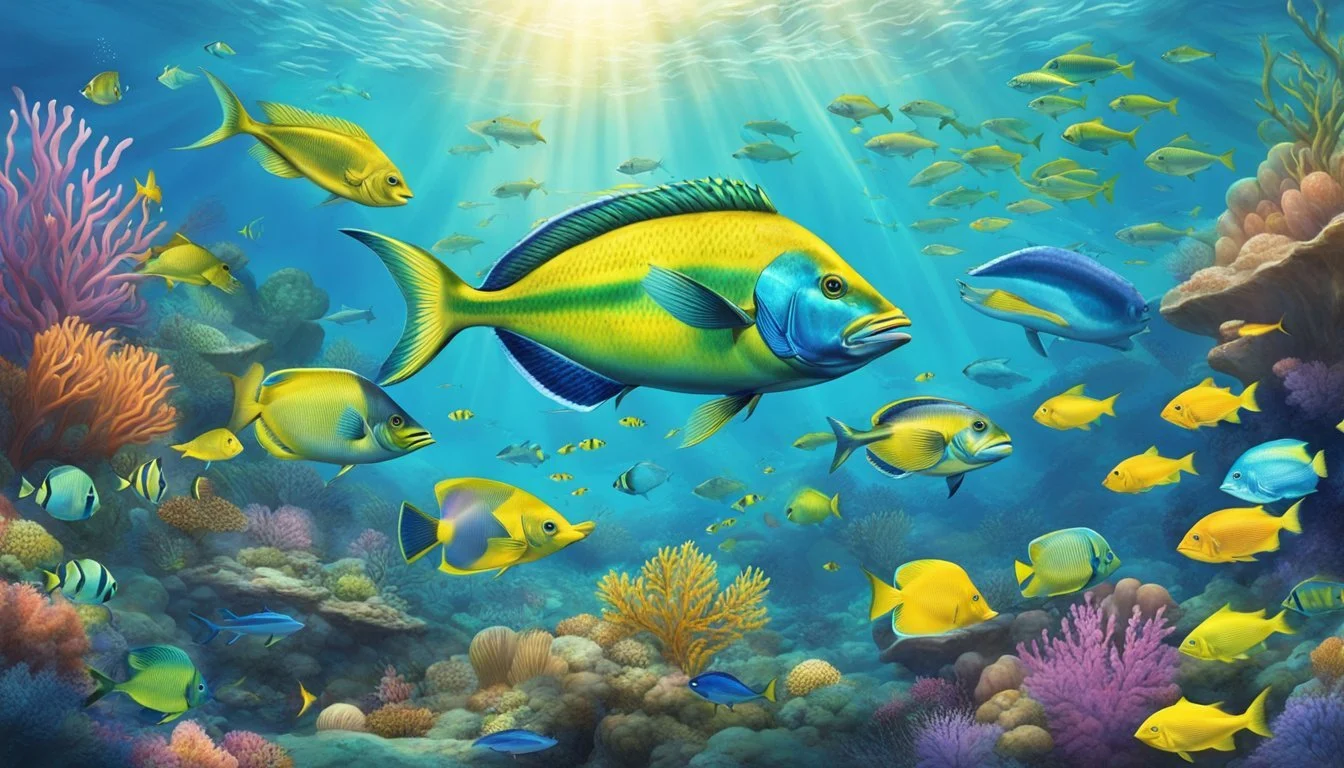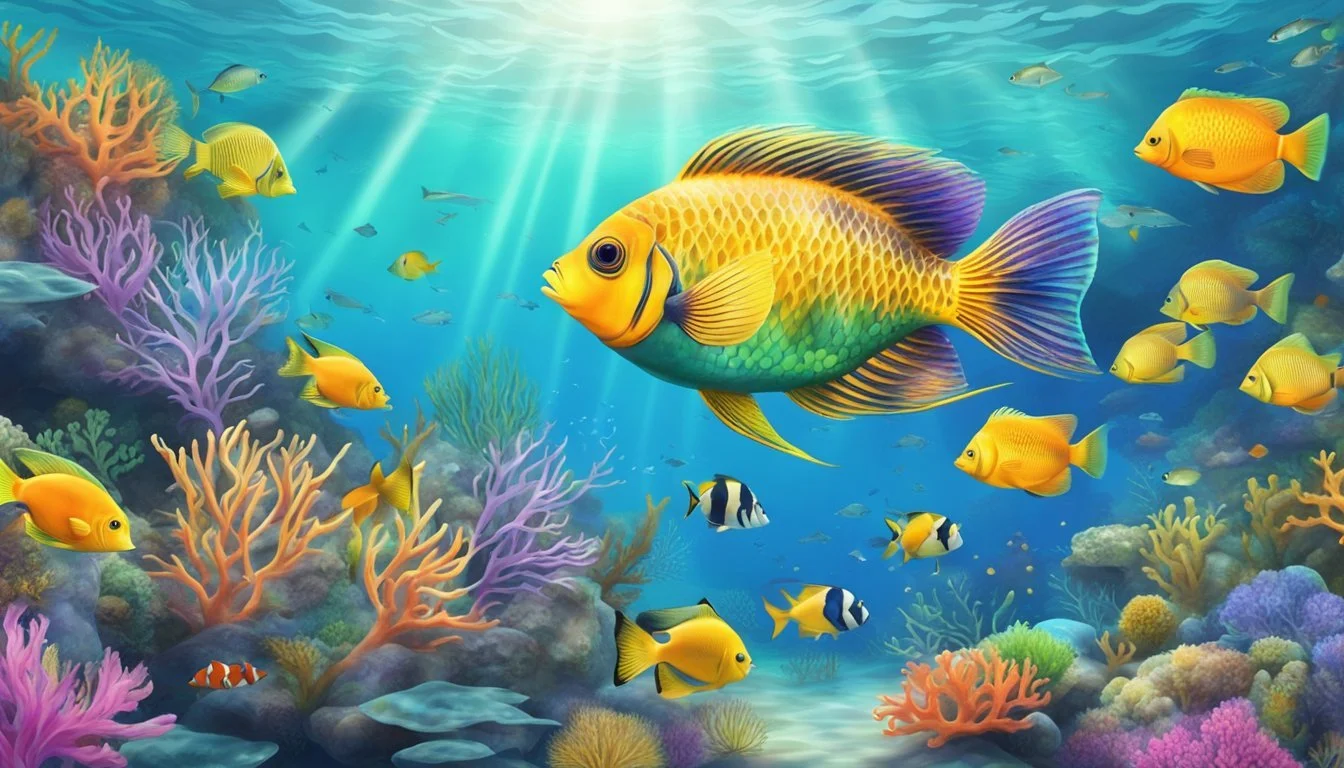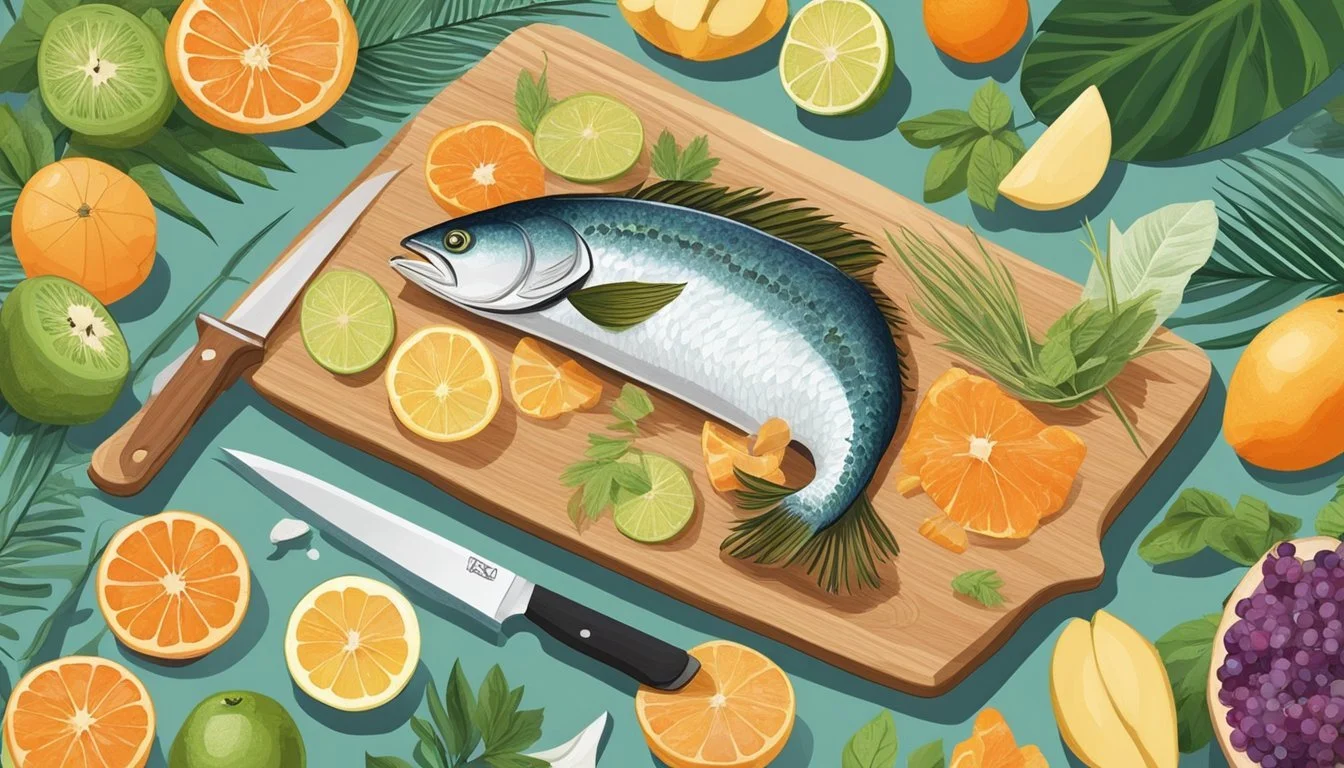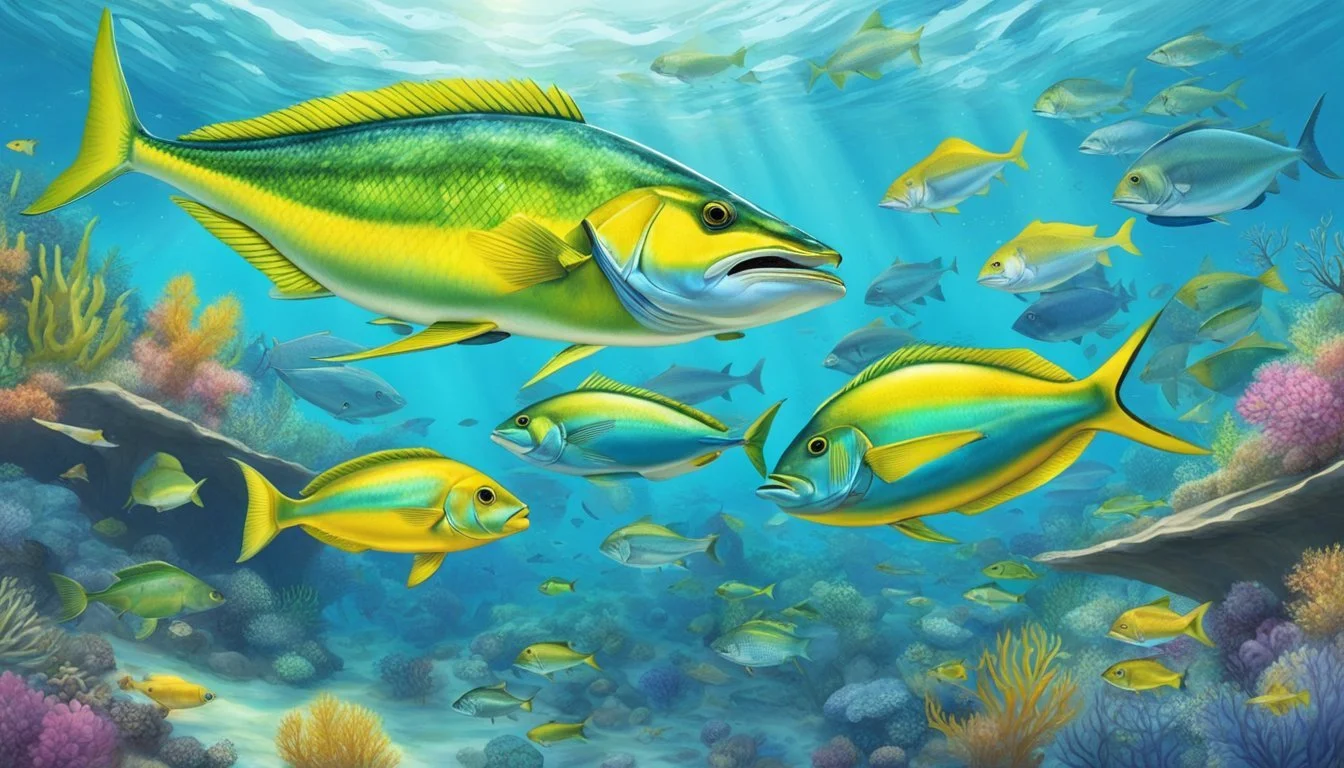Best Fish to Catch and Eat in Hawaii
Your Ultimate Guide
Hawaii's waters offer a diverse and bountiful array of fish (What wine goes well with fish?), making it a prime destination for anglers and seafood enthusiasts alike. The island chain is renowned for its unique marine life, with many fish species unavailable elsewhere. From the deep-water hunts for the big game to the more accessible nearshore catches, the experience is as varied as the marine life itself. Consuming the day's catch is a delightful tradition here, where the freshness of the fish guarantees a culinary experience unlike any other.
Culinary traditions in Hawaii pay homage to the ocean's bounty, with methods of preparation that accentuate the natural flavors of the fish. Species like the vibrant Mahi Mahi, the lean and firm-textured Ono, and the mild sea bass known locally as Hapu'upu'u are just a few favorites among the islands' many options. These fish are not only treasured for their sporting qualities but also for their culinary versatility, lending themselves to a variety of dishes from steamed and baked to grilled and served raw as sashimi or in Hawaiian poke.
Local fishermen respect the ocean and its offerings, employing sustainable methods to ensure future generations can enjoy the same abundance. Dining on locally caught fish is not just a palate-pleasing adventure; it's a way to connect with Hawaii's cultural heritage, where the relationship with the sea is deeply interwoven into everyday life. With this intimate connection, the islands' inhabitants and visitors alike can partake in a culinary tradition that celebrates the sea's generous spirit.
Fundamentals of Hawaiian Fishing
Hawaiian fishing is as much about tradition as it is about sport and sustenance. Offering a diverse range of fish, it's essential for anglers to understand the local techniques and adhere to regulations to maintain the ecological balance.
Fishing Techniques in Hawaii
Hawaii's rich aquatic life necessitates a variety of fishing methods. Local anglers often employ shoreline fishing, which includes the use of casting nets, poles, and spears, to capture nearshore species such as Moi, which is known for its moist texture and is a popular dish when fried. Offshore, deep-sea fishing is prevalent, targeting larger fish like the Aku (Skipjack tuna (What wine goes well with tuna?)), using methods such as trolling or using live bait.
Common Techniques:
Shoreline Fishing: nets, poles, spearing
Offshore Fishing: trolling, live baiting
Regulations and Sustainability
Regulations are in place to ensure the continued abundance of Hawaii's marine life. Anglers must be aware of fishing seasons, size limits, and bag limits, which are enforced to promote sustainability. Hawaii Freshwater Fishing Licenses are also a cornerstone of the regulatory framework, ensuring that only licensed individuals partake in fishing activities.
Key Regulations:
Fishing Seasons: Defined periods for fishing
Size and Bag Limits: Restricts the quantity and size of the catch
Licenses: Mandatory for freshwater fishing
Sustainability is further supported by designated Regulated Fishing Areas which protect certain species and habitats. These efforts help to preserve Hawaii's marine ecosystems for future generations.
Popular Fish Species in Hawaii
Hawaii's waters teem with a variety of fish, each revered for their distinct flavors and textures. From the robust Ahi tuna, ideal for sashimi, to the delicate taste of Mahi Mahi, these species are central to Hawaiian cuisine and fishing culture.
Understanding Fish Types
Ahi (Tuna): Prized for sashimi and poke, Ahi is a sushi (What wine goes well with sushi?)-grade fish noted for its rich flavor and firm texture. It encompasses several types of tuna, including Yellowfin (Thunnus albacares) and Bigeye (Thunnus obesus).
Mahi Mahi: This fish is characterized by its mildly sweet flavor and flaky texture. It's versatile in preparation, suitable for grilling or frying.
Uhu (Parrotfish): Recognizable by their vivid colors, Uhu have a more textured flesh that's well-suited for grilling.
Opakapaka (Pink Snapper): Known for its light, nutty flavor which makes it a favorite for baking and steaming.
Omilu (Bluefin Trevally): A fight-worthy catch, Omilu offers a dense texture, often served as grilling steaks.
Menpachi (Soldierfish) and Kala (Unicornfish): These are often enjoyed fried or in soups and stews.
Opah (Moonfish): It's a richer, oily fish that's often grilled or used in stews, known for its flaky, tender meat.
Monchong (Sickle Pomfret): Appreciated for its moist, buttery flesh that is well-suited for a variety of cooking methods.
Milkfish: A staple in Hawaiian households, often boiled or fried, noted for its soft texture and mild flavor.
List of Sashimi/Poke Favorites:
Mahi Mahi
Opah
List of Grilling Favorites:
Uhu
Omilu
Monchong
Seasonal Availability
Hawaii offers year-round fishing opportunities, but fish availability can still be seasonal:
Ahi: Peak season runs from May through September.
Mahi Mahi: Available most of the year with peaks from March to May.
Opakapaka: Caught year-round, but the best time is from October to January.
Uhu, Omilu, and Menpachi: Present throughout the year, with some variations based on weather and water conditions.
The knowledge of when each fish is most readily available not only ensures the freshest catch but also promotes sustainable fishing practices in Hawaii.
Nutritional Profiles and Culinary Uses
The fishes of Hawaiian waters not only offer a delightful culinary experience but are also laden with beneficial nutrients. They vary greatly in textures, from moist and flaky to firm and fatty, each bringing its unique taste and health advantages to the table.
Health Benefits of Hawaiian Fish
Hawaiian fish like Moi, Monchong, and Onaga are rich in omega-3 fatty acids, which are crucial for cardiovascular health and brain function. For instance, the Hawaiian Butterfish, or black cod, has a high oil content, making it a substantial source of these healthy fats. The moist and tender texture of Moi, coupled with its nutritional profile, makes it a sought-after option for a healthy diet.
Monchong: Offers a lean choice, high in protein and low in saturated fat.
Onaga (Red Snapper): Rich in selenium and vitamin A, beneficial for immune health.
Culinary Techniques for Hawaiian Fish
The versatility of Hawaiian fish allows for various preparation methods, each accentuating the fish's natural flavors and textures.
Sashimi and Poke: Onaga and Moi are excellent when served raw, offering a firm texture that is prized in sashimi and poke bowls.
Grilling and Baking: Monchong's delicate flavor is enhanced when grilled or baked, making it a favorite for light, summery dishes.
Frying and Steaming: For a moist finish, deep-frying Moi or steaming are preferred methods, preserving the texture and imbuing the fish with flavors from added spices and herbs.
The affinity these fish have for different culinary techniques, such as baking, grilling, and frying, further extends to how they can be incorporated into various dishes, from soups to sushi and carpaccio. Their texture varies from flaky to firm, allowing for a range of preparations to suit any palate.
Preparing and Cooking Hawaiian Fish
When it comes to Hawaiian fish, the unique flavors and textures offer a range of culinary possibilities. From the ocean to the table, these fish present opportunities for both traditional and innovative cooking methods suited to their firm textures and flavors ranging from sweet to buttery.
Cooking Methods for Fish
Grilled:
Grilled fish maintains a moist interior while achieving a desirable char on the surface.
Firm fish, such as Ono and Mahi-Mahi, excel on the grill due to their sturdy texture.
Seared:
Seared technique is perfect for creating a crispy outer crust while preserving a moist center.
Lean fish benefit from quick, high-heat methods like searing to enhance flavor without drying out.
Frying:
Frying in peanut oil unlocks a fish's full savory potential when done until just firm.
Salt plays a critical role in seasoning prior to frying to amplify the natural taste.
Baking:
Baking allows for an even cook and is ideal for recipes that include a sweet or citrus glaze.
Lemon can be added during baking to infuse a zesty flavor.
Broiling:
Broiling suits fish with natural oils, creating a flavorful, crispy exterior.
Buttery fish varieties gain extra richness from the high direct heat.
Sushi:
Sushi-grade fish like bigeye ahi should be handled minimally to appreciate their fresh, natural flavor.
Recipes and Seasoning Tips
For Grilling:
Opt for a simple marinade with soy sauce (how long does soy sauce last?), lemon, and a hint of sweetness from pineapple juice.
Fish like Ono can be seasoned with just salt and grilled to emphasize their natural taste.
For Frying:
A light dredge in seasoned flour can give fish a crispy exterior without overpowering the delicate flesh.
Selecting the right oil, like peanut for higher smoke points, ensures a crispy, non-greasy finish.
For Baking or Broiling:
A glaze made with garlic, ginger, and a touch of honey can compliment fish with a firm texture.
Moist fish varieties stay succulent when baked with a protective crust or topping to shield them from direct heat.
For Sushi:
Less is more; serve sushi-grade fish with a dab of wasabi and soy sauce to enhance their flavor.
When crafting Hawaiian seafood dishes, (What wine goes well with seafood dishes?) the chef's intuition guides the choice of cooking method and seasoning to create a meal that honors the fish's origin and characteristics.
Best Fishing Locations in Hawaii
Hawaii's diverse fishing locations offer a rich experience for anglers, from the serene shores to the deep ocean waters teeming with life.
Shoreline and Deep-Sea Spots
Shoreline Spots:
South Point, Big Island: Known as Ka Lae, this is the southernmost point in the United States. The confluence of ocean currents here creates an abundant habitat for fish like red snapper and Ulua.
Kaena Point, Oahu: Positioned on Oahu's westernmost tip, this remote spot is excellent for catching ulua and papio.
Mokuleia Beach Park, North Shore: Secluded and picturesque, it's an ideal spot for bonefish.
Deep-Sea Spots:
Hanauma Bay: Not just famous for snorkeling, the clear, reef-protected waters off Hanauma Bay also provide prime deep-sea fishing locations for trevally, mahi-mahi, and tuna.
Guided Fishing Excursions
Guided excursions offer valuable local knowledge for both novice and experienced anglers. In Honolulu, a variety of charter services provide tourists and locals with memorable fishing experiences that target specific Hawaiian fish. These excursions not only guide you to the best fishing spots around the reefs but also give a chance to catch heavier game fish further from shore.
Where to Eat Fresh Fish in Hawaii
Hawaii offers a myriad of dining options where visitors and locals alike can savor freshly caught seafood. With a focus on local restaurants and traditional Hawaiian fish dishes, one can experience the true flavor of the islands.
Local Restaurants and Markets
Nico's Pier 38 in Honolulu is renowned for its fresh fish, which they boast is "almost straight off the hook." Offering outdoor seating, delivery, and takeout, Nico's provides a comfortable and convenient dining experience with a focus on local seafood. Another Honolulu favorite, Fresh Catch, presents a wide variety of Hawaiian fish prepared with unique sauces that enhance the flavors.
On Oahu, seafood lovers can indulge in island favorites at Paia Fish Market Waikiki and Azure, each known for their fresh offerings and distinctive ambiance. Mitch's Fish Market and Sushi Bar also makes the list for those seeking sushi and a variety of seafood options.
Fish Dishes at Hawaiian Eateries
Hawaiian poke, a staple across the islands, showcases local fish like ahi (tuna) in a raw, marinated form. Eateries like Ono Seafood take pride in preparing this dish with the freshest fish, seasoned with an array of traditional Hawaiian ingredients for authentic flavor.
For those seeking a sit-down meal, the grouper or sea bass known locally as hapu'upu'u is often found on menus. Endemic to Hawaiian waters, this mild and delicate fish is commonly served steamed, baked, or fried, allowing diners to enjoy its natural taste profile. Other popular fish include mahi-mahi and uku, the latter known for a mild flavor and firm texture, often found in local cuisine.
Conservation and Ecological Impact
In Hawaii, the decisions on fishing practices and conservation significantly affect the health of local ecosystems and the long-term viability of fish populations.
Impact on Local Ecosystems
Hawaii's marine ecosystems are complex and delicate, with coral reefs serving as the foundation for a diverse array of aquatic life. Pollution from sources such as agricultural runoff and sewage systems has negatively impacted fish biomass in these environments. Overfishing through techniques such as spearfishing, aquarium collection, and the use of lay nets also greatly threatens the ecological balance.
Supporting Sustainable Fisheries
Regulations play a pivotal role in ensuring the sustainability of Hawaii's fisheries. Efforts include quota systems, which limit the amount of fish that can be caught, ensuring that fish populations remain stable for future generations. Protecting endangered species and critical reef ecosystems within designated conservation areas, like the Papahānaumokuākea Marine National Monument, helps to uphold marine biodiversity. These measures support both the health of coral reefs and the livelihoods of local communities reliant on fishing.







